Arriving in Arequipa the altitude was just above 3000 m. I’m descending to the ocean, on halfway I feel sick. Am I poisoned from the food I ate? Then, I started to vomit and after a few minutes I have a headache. Since I left the town my arm started to ache again. Dude, what the hell is happening? For a while I lay down inside an empty bus stop at the roadside which I came upon. Starting to feel better, I decided to continue. Before starting to ride again I looked back shortly.

I’m riding to the west that is to the ocean shore. There is a small town, and it will be better if find somewhere to stay, not camp since I don’t feel so well. While descending, it got cloudy at 2000 meters altitude. On top of it, it started to rain or better said raining cats and dogs. There is almost no visibility. As I arrived 1500 m altitude, I started to see rocks rolled down on the road. Not small rocks, one can kill you if you got hit. What the hell? I get closer to the mountain side, because all the rocks seem to hit the road at the middle to the open side. After a while there are so many rocks on the road which makes it impossible to cross for cars.
Either you clean the stones or a grader. The soil is not that soft to let the stone to roll down, very curious. I continue to descend. 1000 m – 800 m. Then I come upon a truck line. Is the road closed? People are looking at me, and I’m at them. At the same time, I see the town in front of me. The international Pan American road is also just in front of me. The left side goes to Chile and the right side to the capital Lima. A motorbike passes me. The latitude is 600 m and I look at the motorcyclist. What the hell? People scattered on the road start to run after the motorcyclist. Fuck. What if those people recognize me? I was riding next to the trucks and stayed more hidden, therefore people didn’t recognize me. The motorcyclist also didn’t understand what was happening at first but then speeded up. During that short time I realized that I couldn’t arrive in the city in a short time and have to turn to right towards Lima in shortest time possible. People had blocked the roads and didn’t allow anyone to pass. Too late to stop, a couple of people recognized me, then as the other saw me I stood up on the bike to ride fast as I could! As the whole group of people had recognized me, I already had turned to the right on the junction toward Lima riding as fast as could. In seconds, as I look back, I saw that people were running towards me. The road was going to continue to descend from 600 m to 100 m, I hope there aren’t any people waiting ahead. I hear people shouting behind me, but I speeded that they couldn’t reach me anymore. Down I speeded to 80 km/h, before the slope ended, I saw that the road was blocked stones and wood. I knew from the news that Venezuelans had departed towards Chilean border but had never thought that I’ll come across with the crowd in such a way. I don’t thing that they were running after me for pleasure. Down at the end of the slope the road started to climb again. Once more I came up to trucks parked on the roadside. It started to rain again. Dude, what the hell? Today, everything had piled on top of each other. I ask to one of the drivers: “What is happening?”. The Venezuelans had blocked the Peruvian side of the Pan American road, and more people were approaching. Peruvian government was saying that they couldn’t accept so many immigrants. Also, Chile closed its borders to Venezuelans. Most Venezuelans who stuck at the border go deep into the Atacama Desert and try to cross into Chile from those points illegaly. Desperate people were walking for days in the desert for trying to enter Chile. Chilean government remained solid regarded this issue to avoid the immigrants enter the country. They started to control their border with drones trying to avoid Venezuelans to enter the country illegally. But it seems impossible. You can see those people from Colombia till Chile on the Pan American road.
After starting to ride on the Pan American road, I could observe under which conditions those people were moving. I gave water and food to some of them, but the situation was far beyond me. Every Venezuelan asked for help I saw on the road. Water, food, money how I can help to everyone? There is 200 km desert to pass, if I give some water than I’ll get dehydrated, if I give food then I won’t be able to eat anything. I have a tight budget and my capacity to carry stuff on the bike is low. At those moments, my memories in Africa come in my mind. If you share your water you die, if you share your food you die, if you share your medication you die. You have to battle for your life. I thought this was over after Africa, but it seems not. At a hot day I was resting under the shadow at a facility, Venezuelans also came to the facility. They asked for food and water but were not given. Among them were two children about 15 years old. It seemed that they were on the road for a long time and were very hungry. But what can the owner of the facility do? It is not an issue of 3-5 people, if you help one, you have also help to the hundreds of others coming. Those people are trying to run a business, they are not a relief organization. Those children were looking exhausted. I opened my GPS device and checked the nearest city. 220 km away, seem I can arrive the next day. I bought meal for both families and some dessert for children with the cash money I had. The owner had to take these people to the back of the facility, so that the others won’t stream in. After paying all, I continued because I ran out of cash. My farther had always said: “Always keep some extra cash in your pocket and if you spend replace it in shortest time.” So, I left the facility towards the nearest city. On the rest of the Pan American road, I had to ignore the crowd. On the evening when hundreds of people run towards me, there were buildings under construction and 3-4 finished buildings on the right side. I put up my tent in one of these unfinished buildings. I shared my location on the Whatsapp South America group and on my webpage. Also, informed Turkish Lima Embassy what had happened and sent the coordinates of the place. Just in case! I’ll stay and sleep here for this night. At least people will know where I’m if they don’t hear from me. The next day, both the people in the Whatsapp group and the employees of the embassy followed me from the webpage. On that day, the Pan American road was empty for a long time. Only me was riding on the road as if I closed this international road for myself.

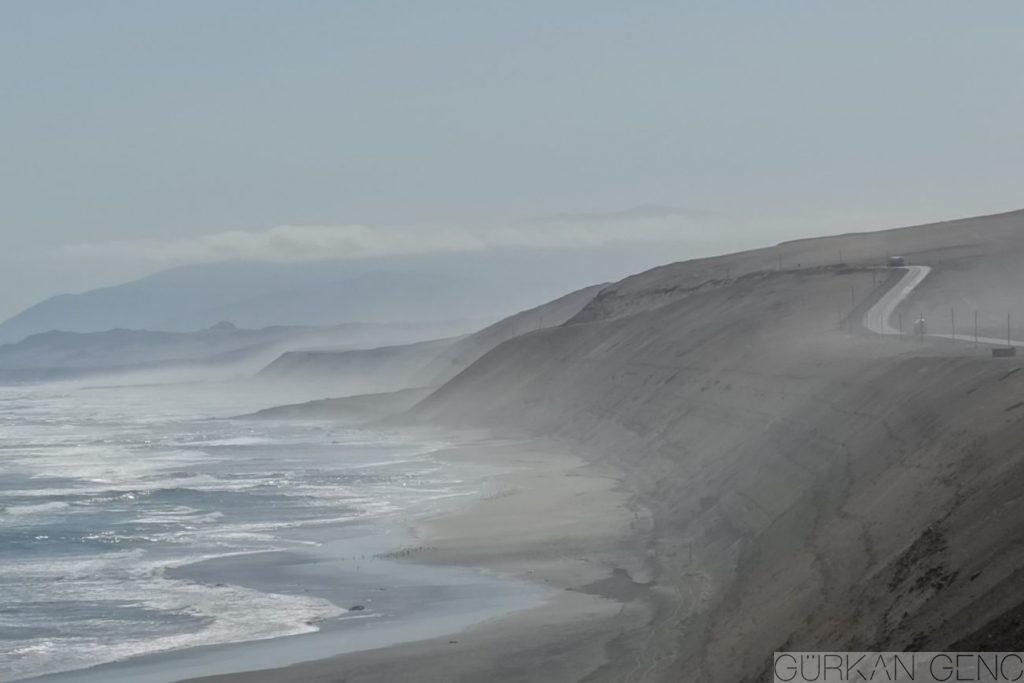
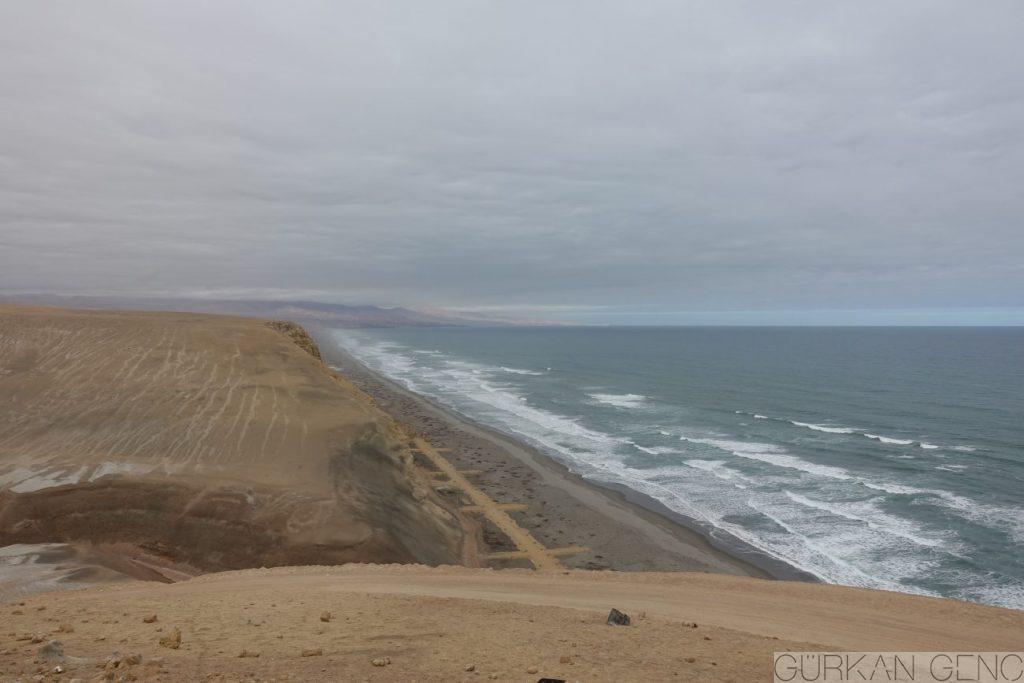
Descending to Ocean side may think that there are no climbs, and you can easily ride along the coast. But not in Peru. The coast has many sharp up and downs, but the coastal road is nice and has a broad shoulder till Lima. There are fertile agricultural lands where the rivers running down the Andes meet the Ocean. Coming close to these river exits the road goes about 4-5 km inland, climbs and then returns to the coast.
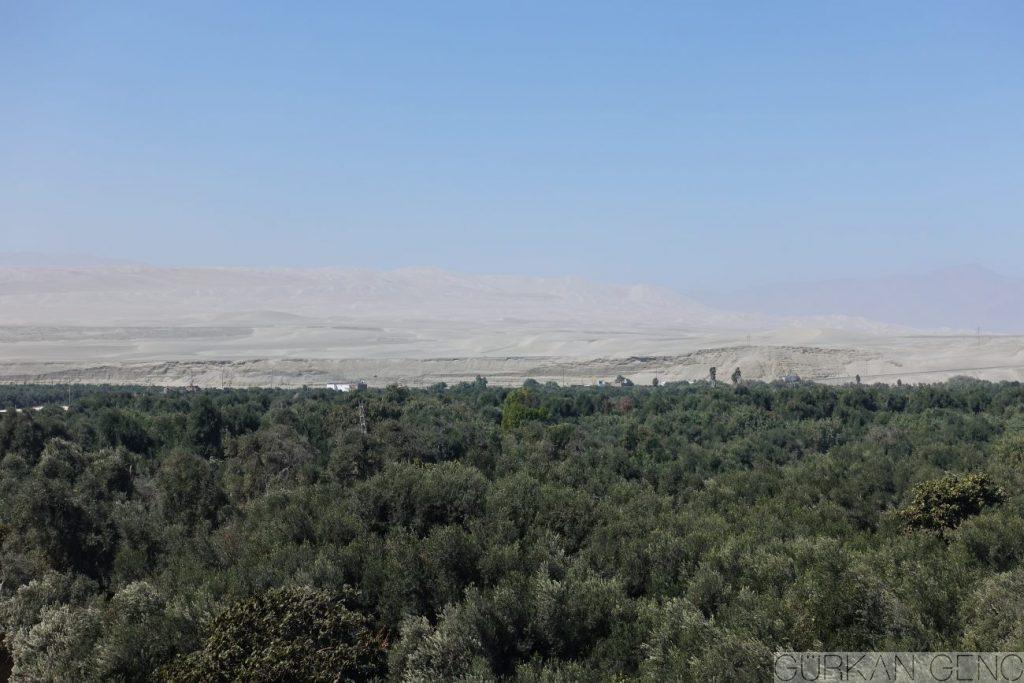

It is possible to see small towns in those regions. However, on the fields at every river exit different agricultural products are grown. In one olive tries, in another vegetables, fruit trees etc. Peruvian cuisine is rich in variety. It is stated that the best cuisin in whole South America is the Peruvian cuisin. Though I didn’t travel through the whole country, I must admit that the food was good. The best sea food, best local food is found in Peru.
While riding along the ocean side, one of the most striking features is the level of ocean pollution. I’m not talking about the color or the foam on the sea water. It is possible to see garbage piles all along on the shore and on the water. Besides this, most of the road between Palpa and Ica towns is level and goes through the desert. Peru, in general, is an insensitive country about environmental pollution.The new generation is not aware of this either. I noticed that they were not aware of this issue in the presentation I gave in a high school in Lima.

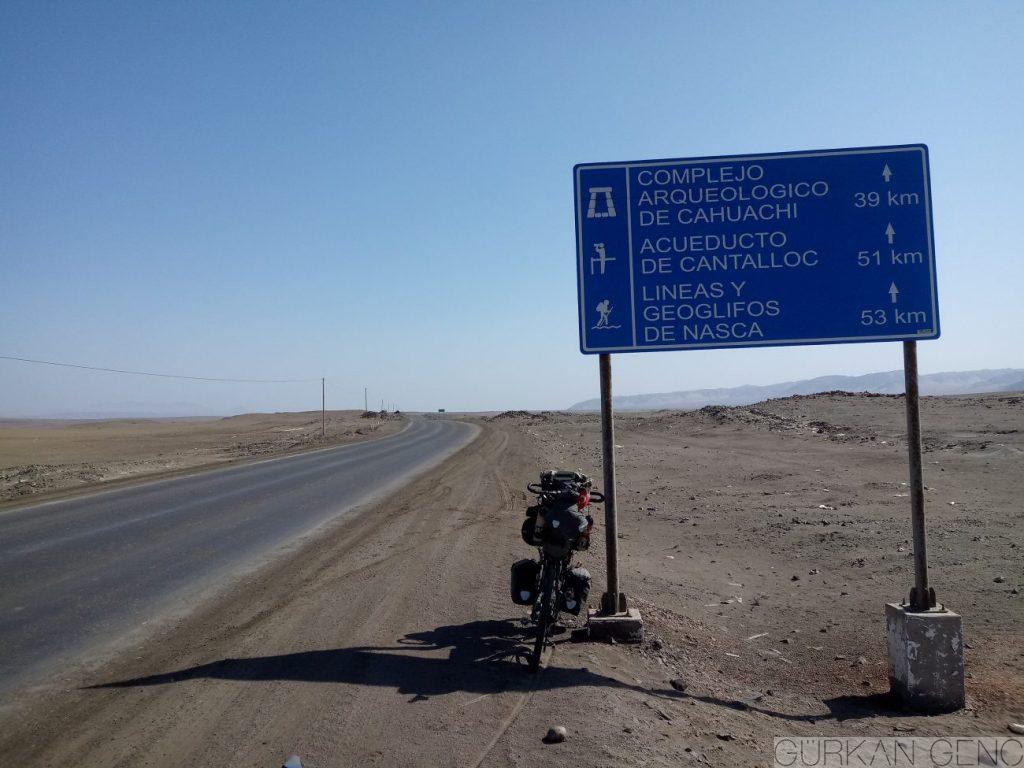

After what I have witnessed on the road between Palpa and Ica, Peru ended at the top of the pollution list among the countries I have visited so far. What I saw and experienced was like a filmstrip. The distance between those two cities is 100 km. The region I rode was 500 m above the ocean level and did not change much in altitude. That is, there were almost no slopes or climbs, a level land. 90 km of the road passes through the desert. The day I was riding on this road a wind from ocean side, that is from the west side, was blowing at a speed of 35 km/h. I was riding from south to north having side wind. I’m not exaggerating, I came upon flying garbage of all type, nylon bags, cardboard boxes, plastic bottles, sanitary pads, diapers, cloth parts, etc along this 90 km. Dude, as if I passed through a portal, to another dimension. Because of the sand particles in the air I had already covered my face. A cardboard box is flying towards me from the left, if it hits it may injure me. I slow down to let it pass by. Another box, I go faster so it does not hit me. Nylon bags stick to my body. Aha, one of these bags squeezed into tire, between the frame and the hub. I got of the bike and tried to remove the nylon bag, meanwhile a cardboard box hit on my back. A diaper was hanging on the side of the rear pannier. Dried poop in front of my eyes. Dude, what a polluted place, how come? How that much garbage could come from the ocean side? Are they depositing their garbage on the desert? Well, this continued uninterruptedly for 90 km. I have never seen, did not ever dream about, such a thing before,

The population of Peru is 33 million and there is a recycle plant in Lima, the only one in the whole country. This pant recycles only basic materials. The whole garbage of the country is buried in deserts or empty places. Well, I got very surprised when I heard this. Then, I saw this with my own eyes, they burry the garbage in empty areas far enough away that the smell is not carried to the settlements by wind. In some place the garbage is burned but mostly buried. I met Hilal and Felix in Lima who hosted me. Hilal is Turk. While she was traveling the world, she met Felix and then they got married. They started to live in Peru. Their memories and stories are as nice as their personalities. He works for construction industry and aside of this environmental pollution he share some other interesting information: Peruvian people don’t want that recycled materials to be used on building constructions. Even though the lower construction expenses, they don’t want recycled materials gained from second hand or garbage waste in their houses. Hilal also encountered similar things a couple of times and says Peruvians don’t lean towards the recycling issue. As in all capitals, also there are nice neighborhoods in Lima. Miraflores region is one of these. I find the hostel Zig Zag through Atilla a traveler I met in Lima. This region is clean and tidy. This makes me surprised since I know the previous history of the city center. I go to one of the most famous high schools of the country to hold a presentation. They welcome me such that as if I’m a famous pop star of their period. I hold my speech in the sports hall to the whole school students.
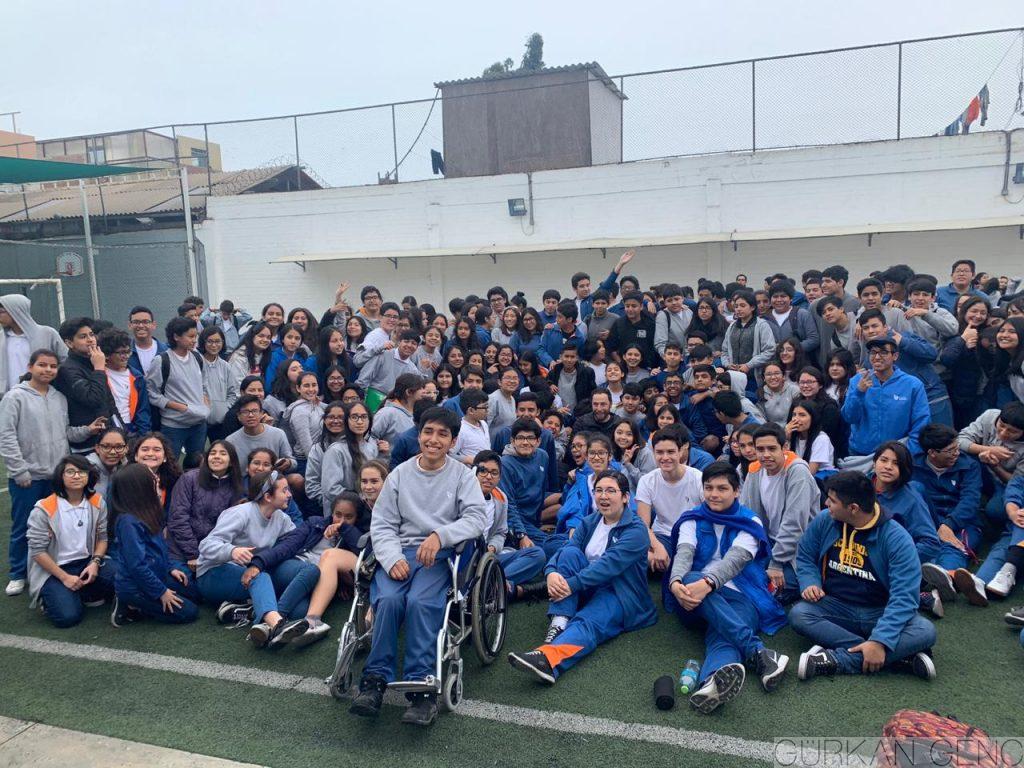
Many of them haven’t traveled in their own country yet. Of course, they love their country and give me suggestions to visit to me. At one part of the conversation:
- Your culture, your country is rich, from the deserts to the Amazonas, from the beauty of the mountains to your rich history, to your meals. It is impossible not to admire your country. But I have to share a fact with you.
They all pay attention:
- Together with your country I have traveled in 60 countries so far in 4 different continents. The dirtiest country I have seen so far is yours unfortunately.
In a second, humming is rising.
- NO, IMPOSSIBLE. Our city is very clean and there are garbage baskets all around in the city. It is impossible to see garbage on the streets.
- Well, you are right. The neighborhood where your school is and where I stay is very clean. I guess the other districts are also clean. But, Peru is not only consisting of some districts!
I start to talk about what I have seen on the road. Talk about, the place where the garbage is disposed by the garbage trucks. They got shocked. I talk about that their country doesn’t have a recycling policy. That there is only a single recycling plant in the country which is in Lima and that this recycling plant is far from sufficient. They silence after I also tell them where the garbage is disposed in all the other cities.
– Look. The world is a living being. We cannot save the world and the living beings on the earth by just keeping North America or Europe clean. Well, we have to keep the world clean for us and for the other living beings. Will you stay alive if you only cure your arm but not your leg if they are both bleeding? No, you won’t! Well, what shall we do after learning all these? Peru is your country and what do you suggest to do to save us?
A long silence. Even there was an immediate expression on the teachers faces. A student raised his finger and told his opinion. Then, 3-5 students joined to share their opinions. Afterwards, 30-40 students started to talk about this issue with new ideas in their mind. They all wanted to share their ideas. At the end of the presentation, I asked them to share their ideas with their teachers and said that the power to change their future is in their hands. Before leaving, the school principle came to me:
- Never before had someone talked to our students like this. I appreciate that you shared your experiences and your opinion about our country with us and the students. Thank you very much.
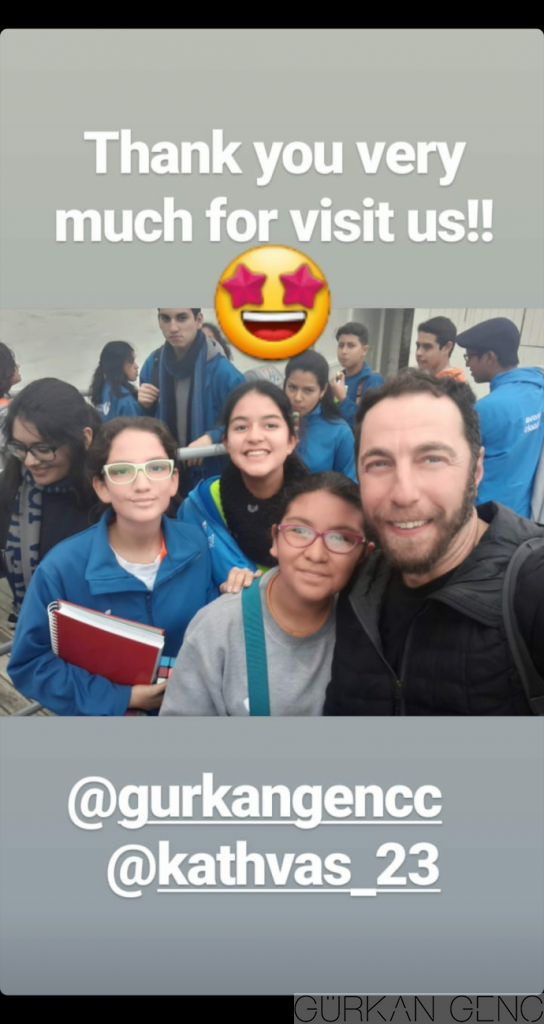
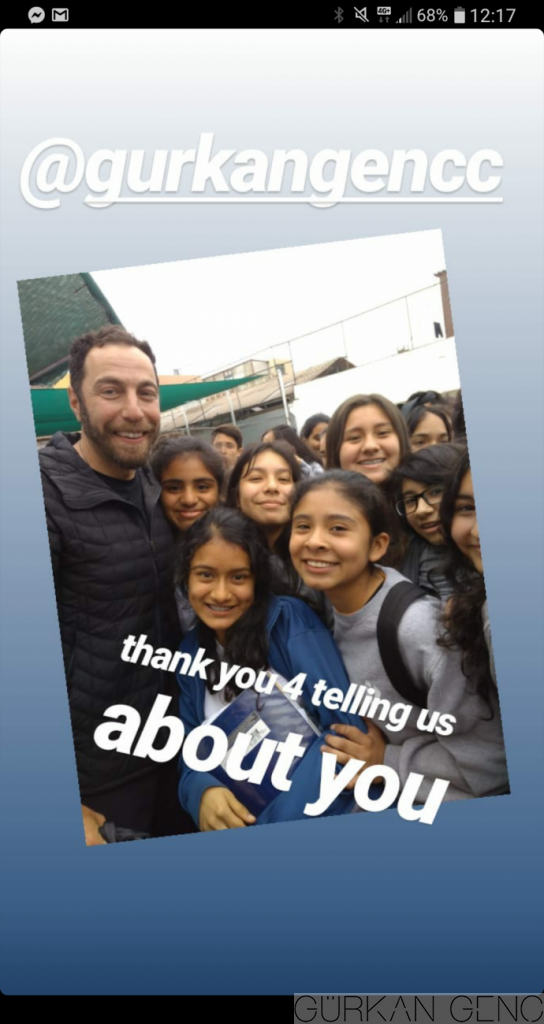
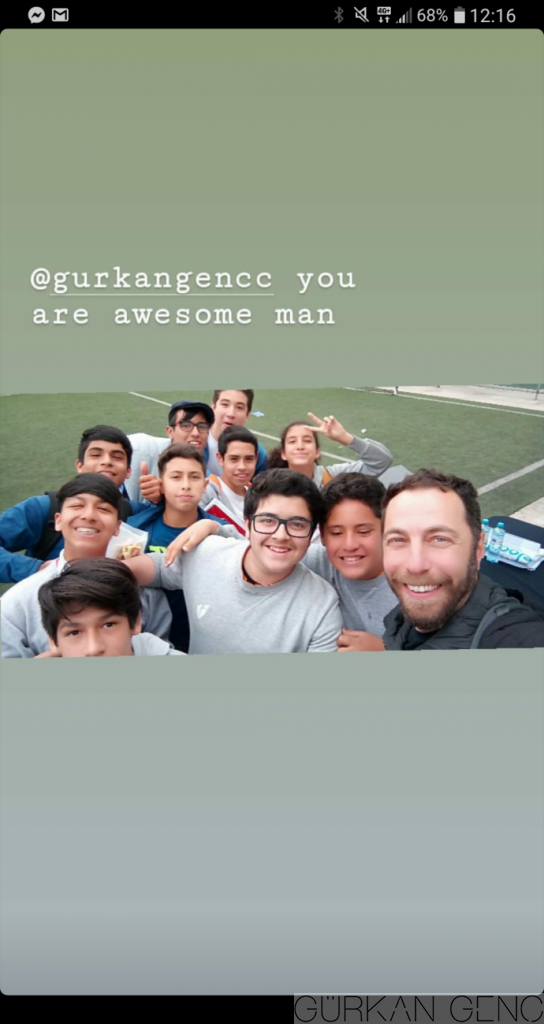
There are specific iconic spots which comes into mind when you mention Peru. Machu Pichu, Titicaca Lake, Nasca Lines, Hidden Valley. The colonial dwellings in some small towns and cities, museums, sand dunes, etc. Among these sand dunes, there is a small lake, villages around the shore. Everyone goes there because it is famous. This area is outside the town Ica. Well, I didn’t go there. I went to a much less known place, Oasis de Moron, where there is only a small lake, a natural beauty.
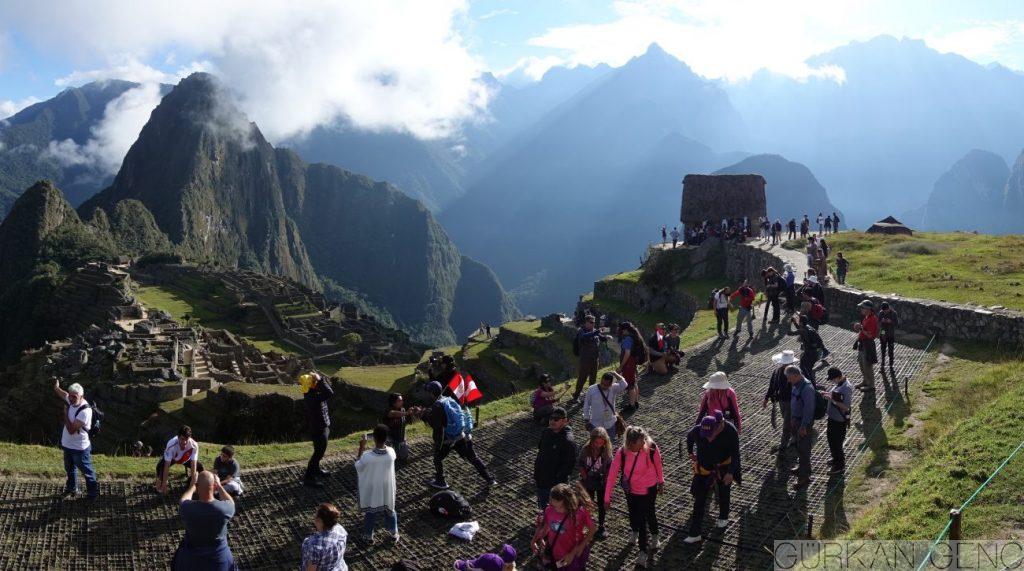
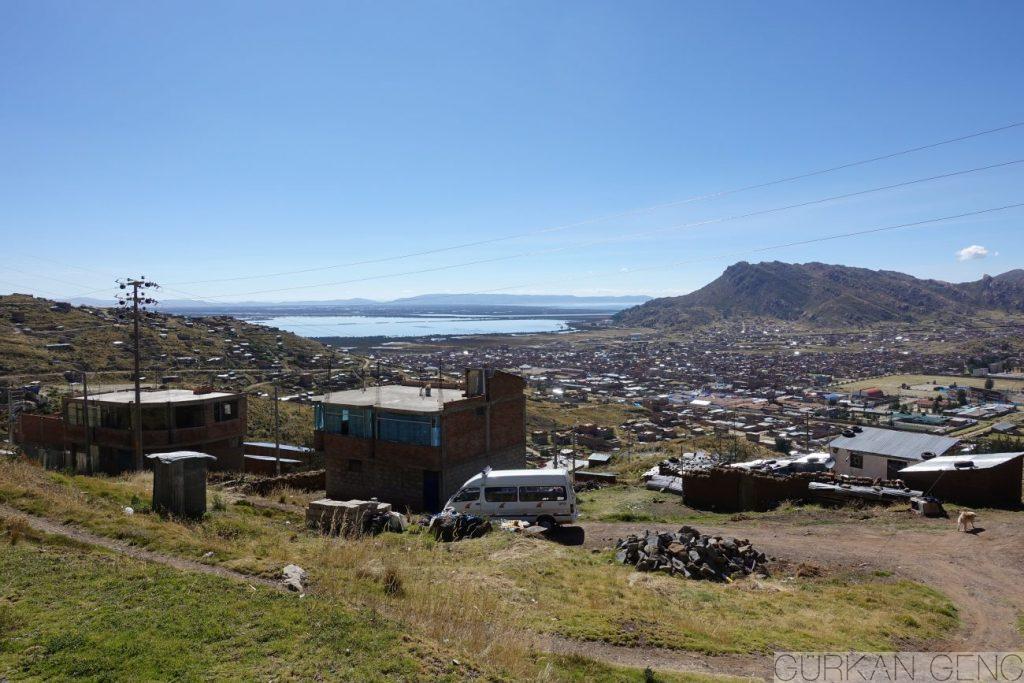
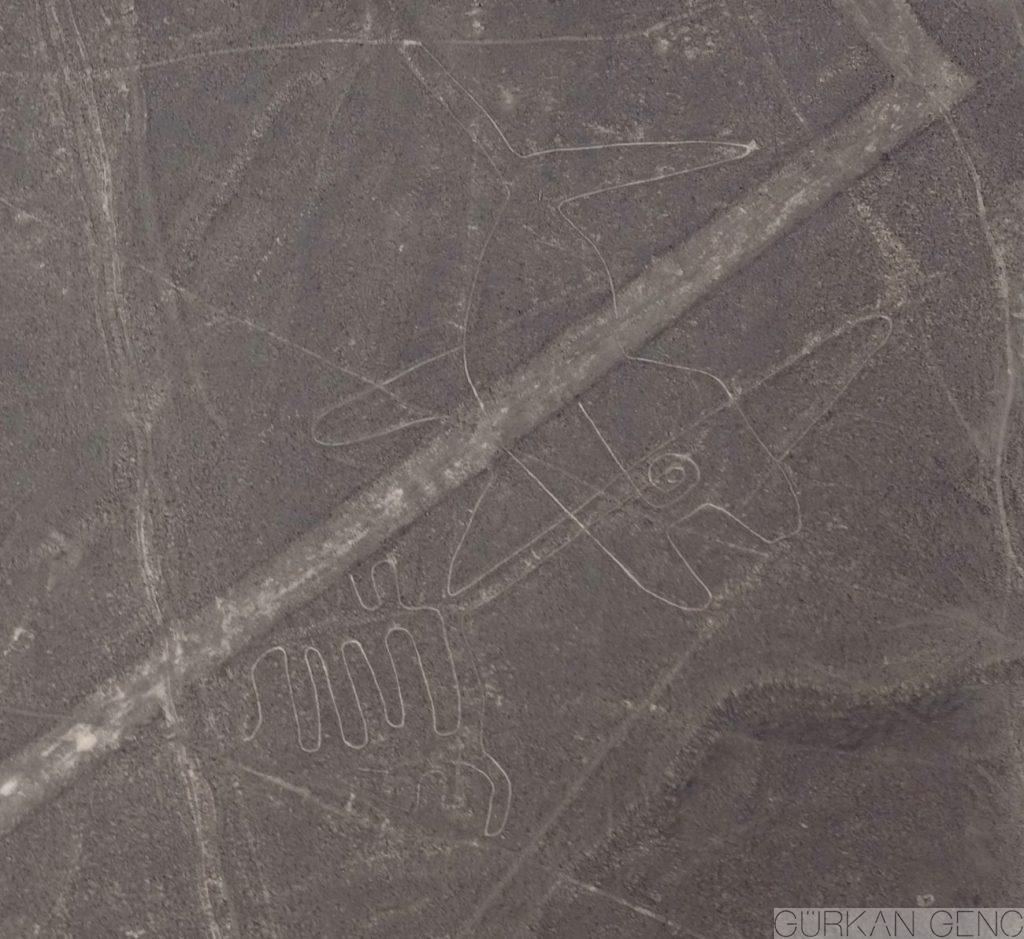
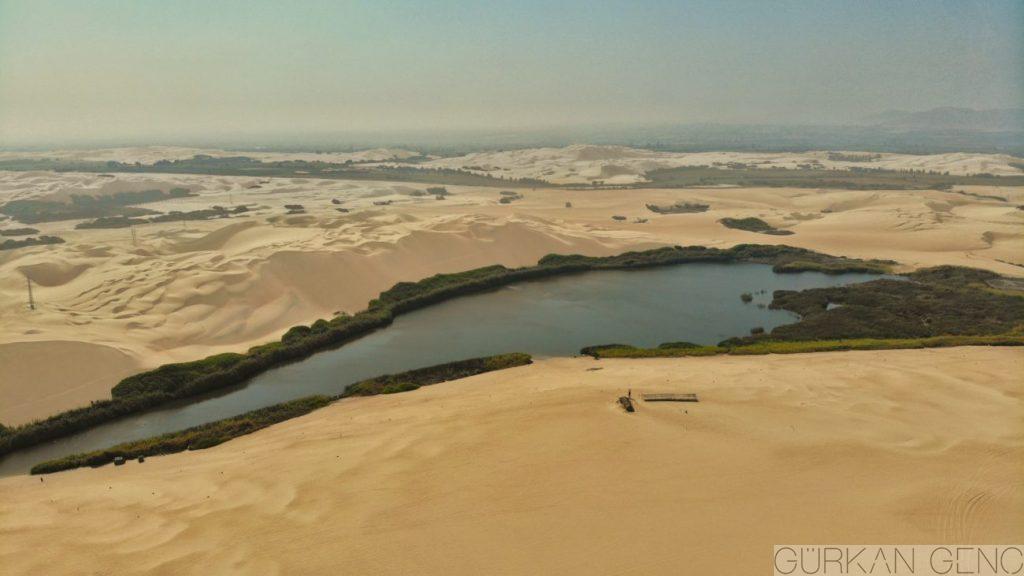 (This lake is bigger than that in Ica. There is no settlement around the lake. People come here with vehicles to drive off-road or to sand board over dunes).
(This lake is bigger than that in Ica. There is no settlement around the lake. People come here with vehicles to drive off-road or to sand board over dunes).
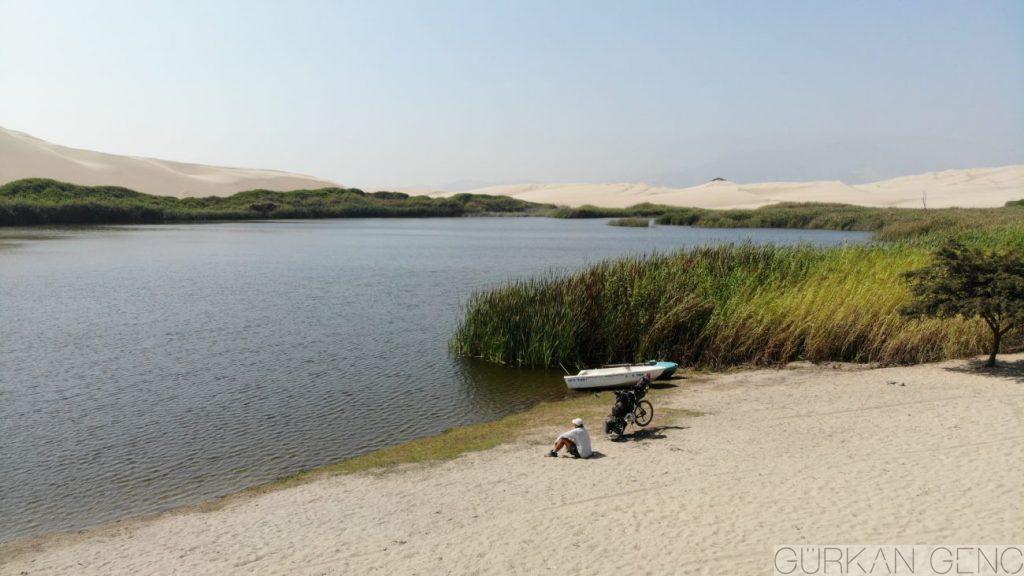
Honestly, I didn’t go there to see that place, it just was en route. Since I have seen plenty of these sand dunes in Arabian Peninsula, those sand dunes don’t catch my attention anymore. I choose this route because I wanted to see one of the best examples of mud-brick dwellings lasted from Inca period.
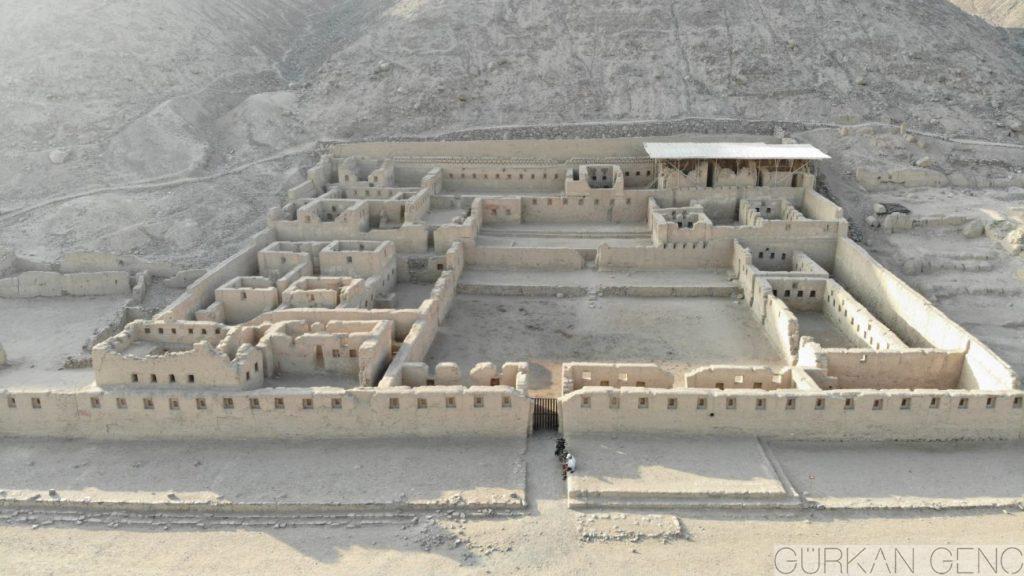
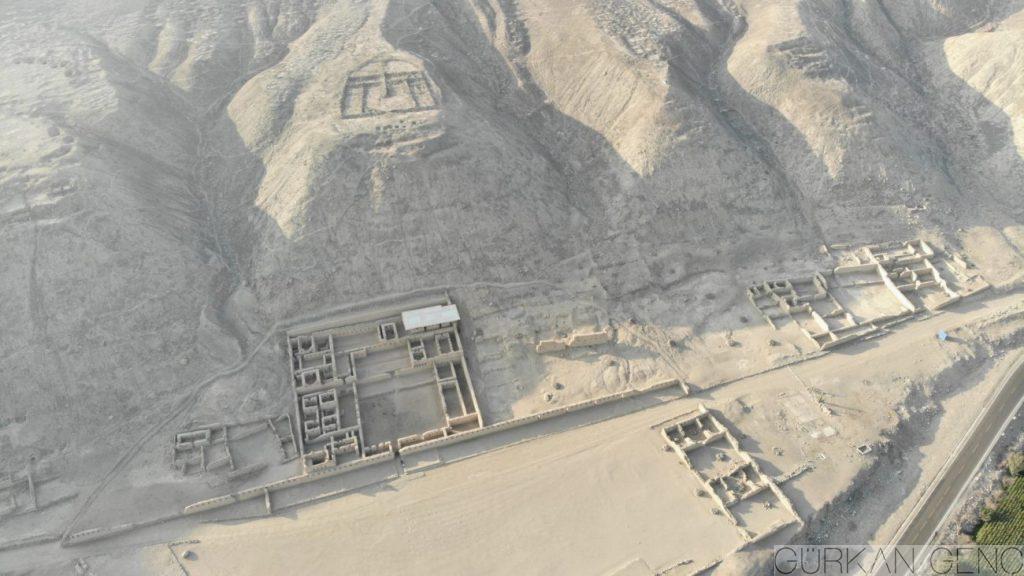
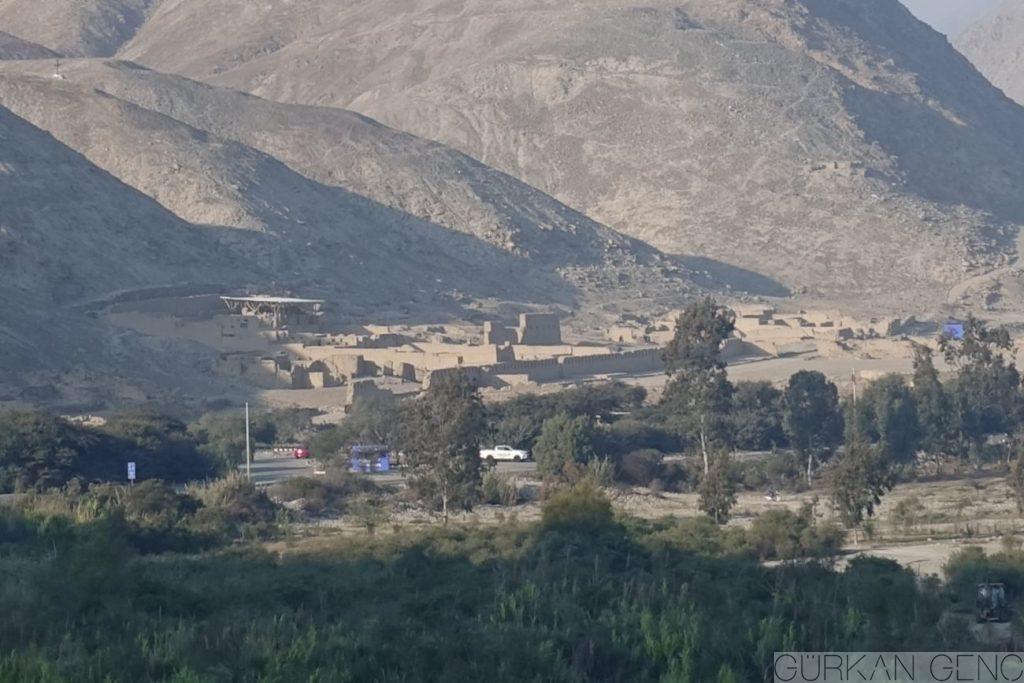
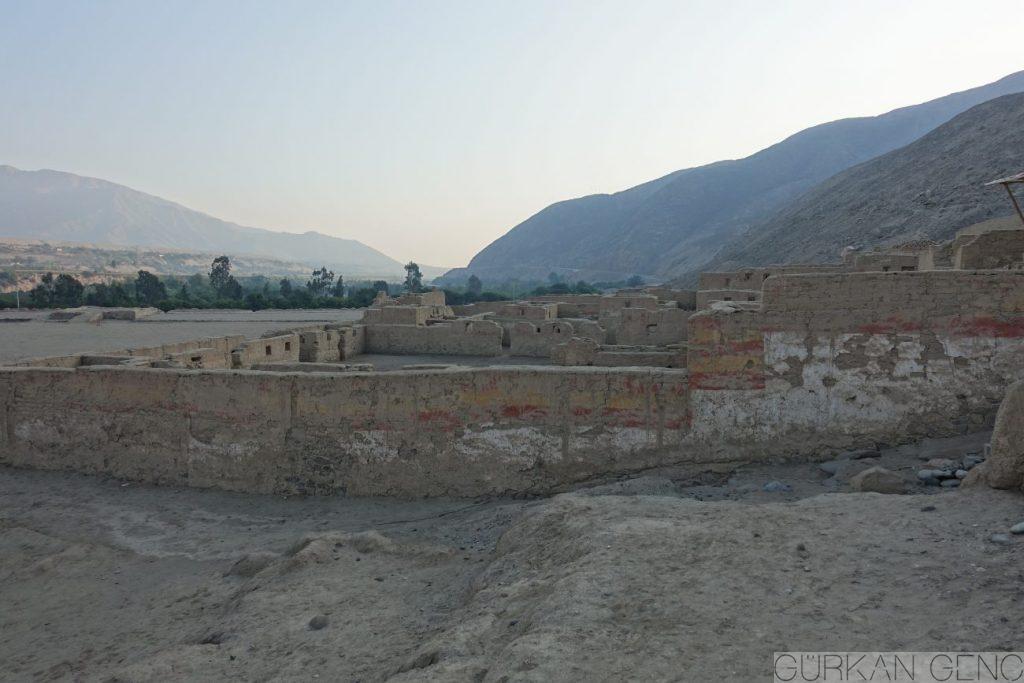
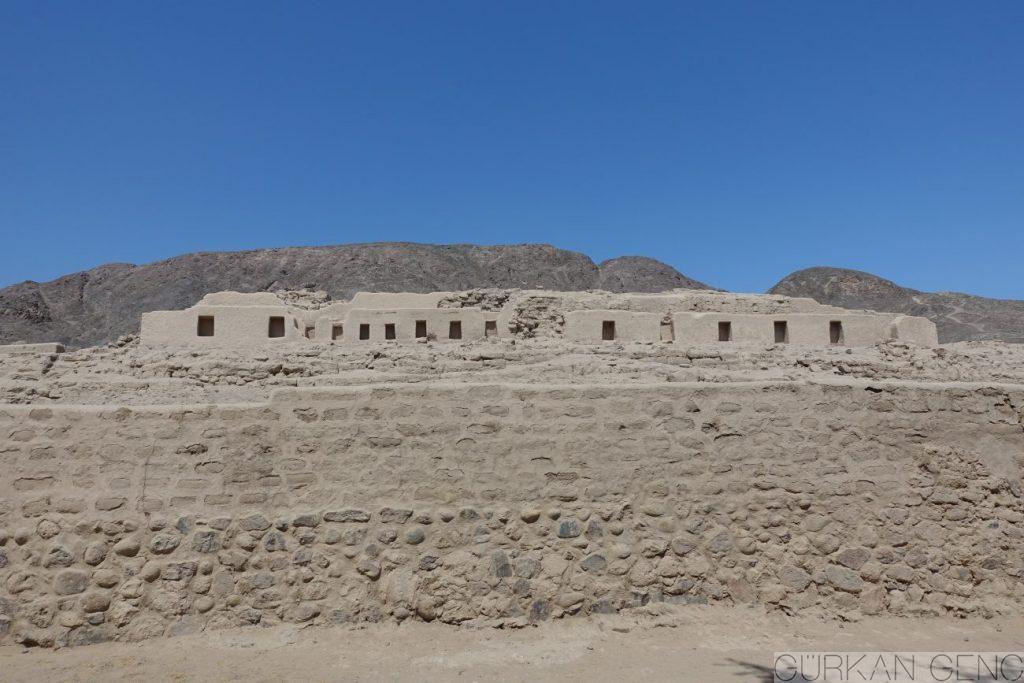

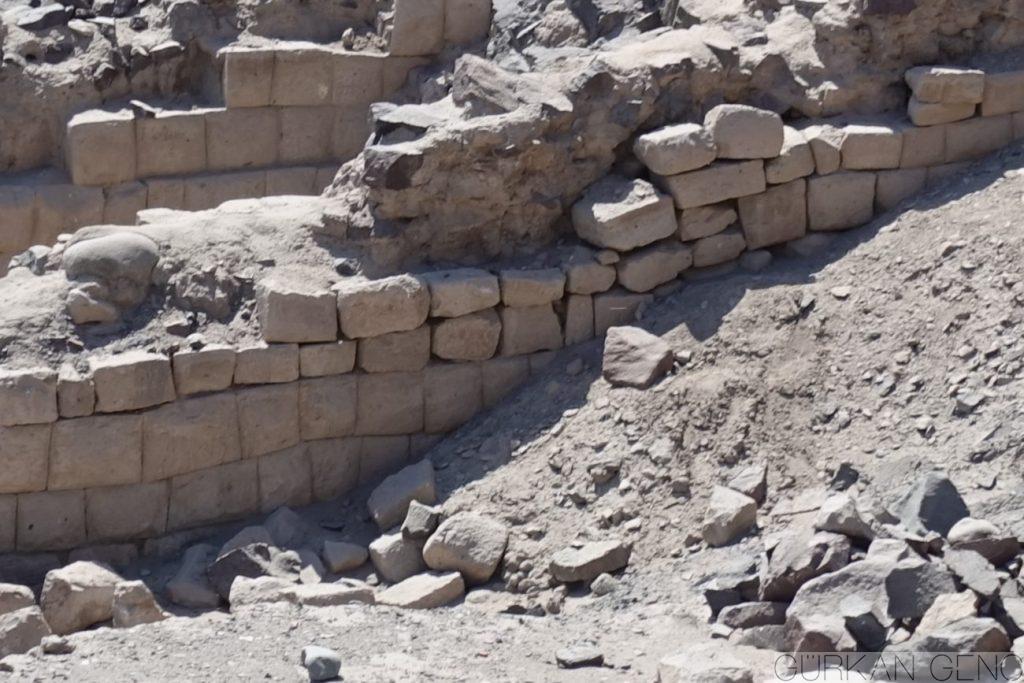
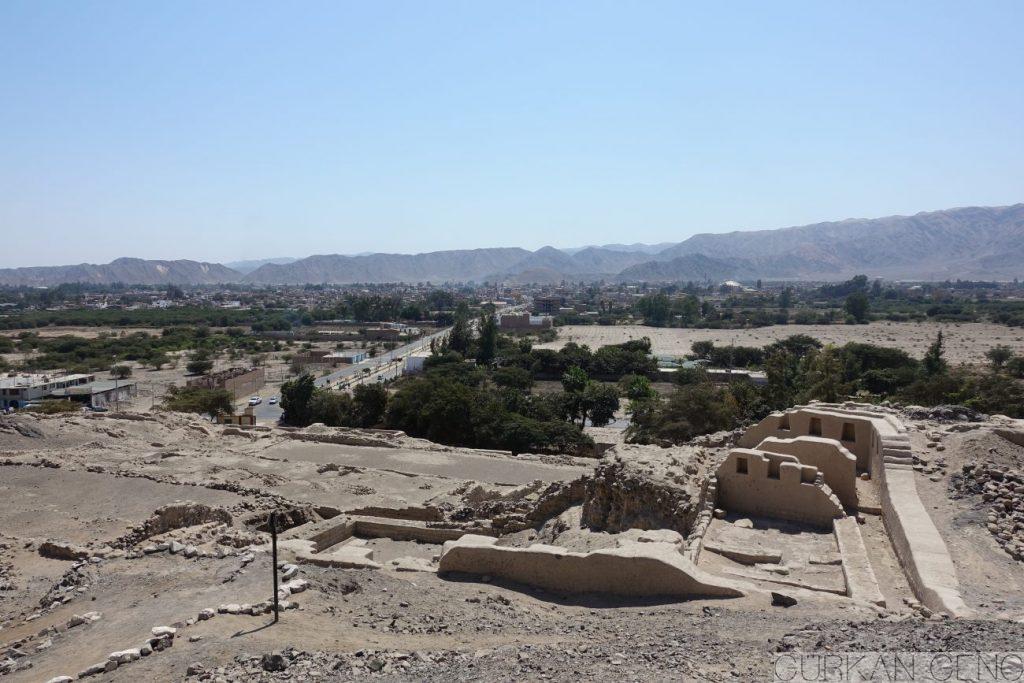

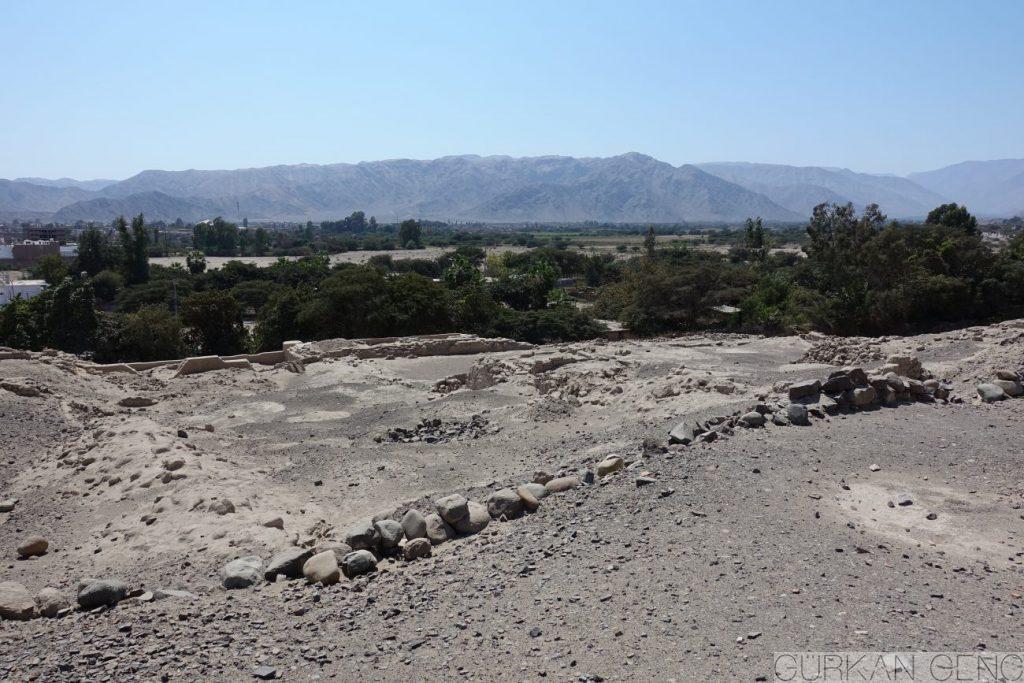 Tambo Colorado is somewhat like a front checkpoint and is a place where the people living around sell their goods on open market. A similar one is on the road to Nasca. I had been informed about this place during my walk on the archeological site in Nasca.
Tambo Colorado is somewhat like a front checkpoint and is a place where the people living around sell their goods on open market. A similar one is on the road to Nasca. I had been informed about this place during my walk on the archeological site in Nasca.
When you talk about Nasca, the first thing it comes in mind will be the Nasca Lines. Even, while we were talking with my father about the route of my world travel before I set off from Turkey, he was curious about two spots in South America: One was Rapa Nui, also known as Easter Island and the other was the Nasca Lines. He only had the time to read my Easter Island memories before he passed away. I boarded a plane to see the lines from above and visited the city for him.
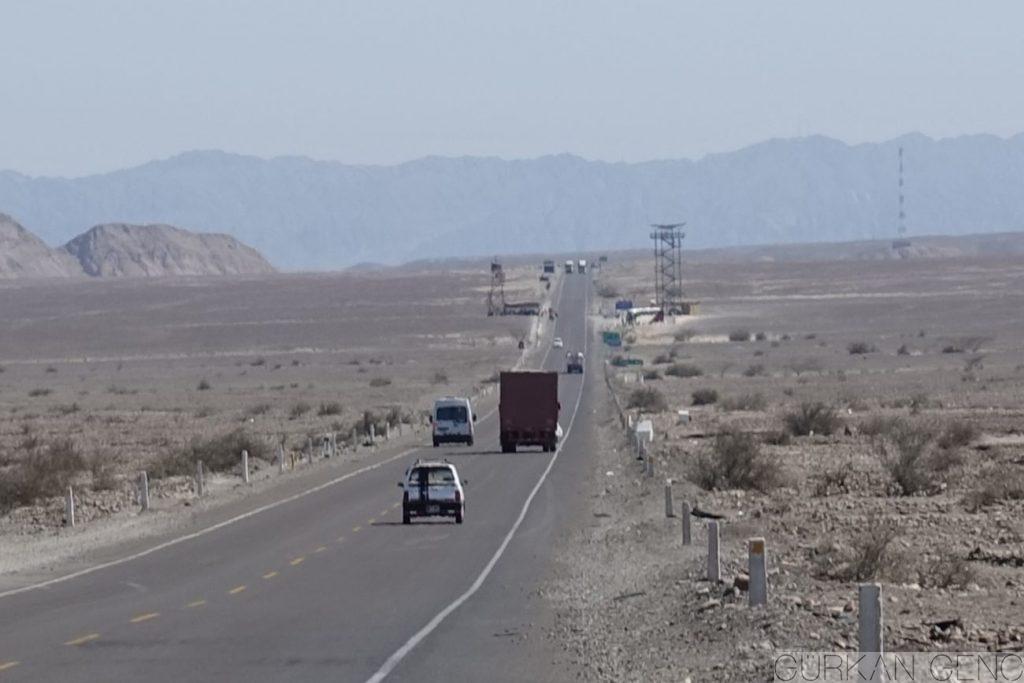
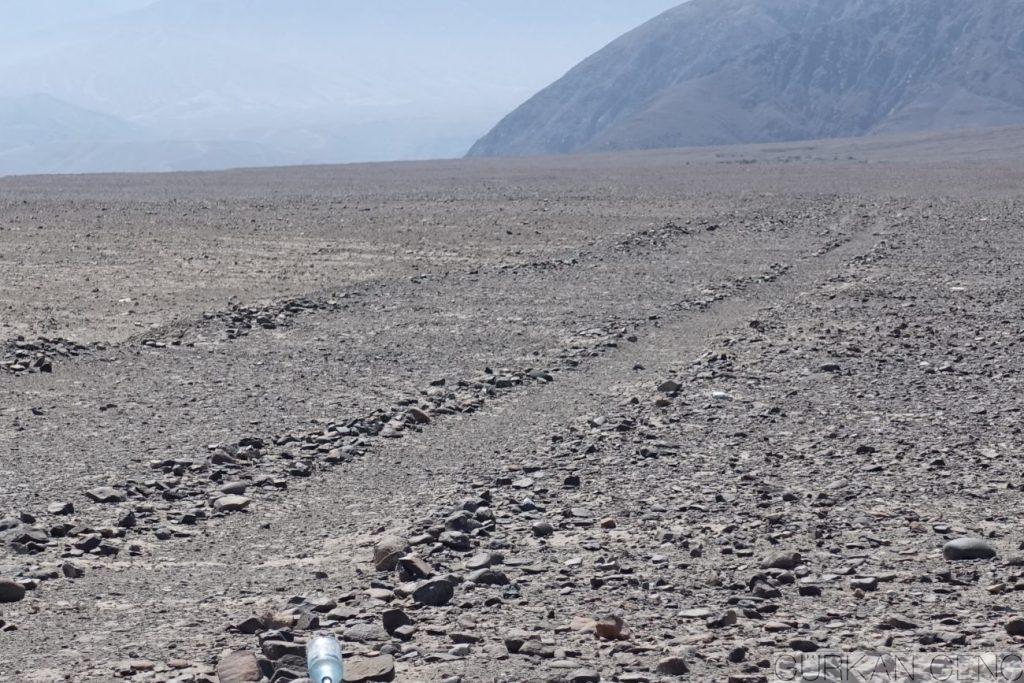
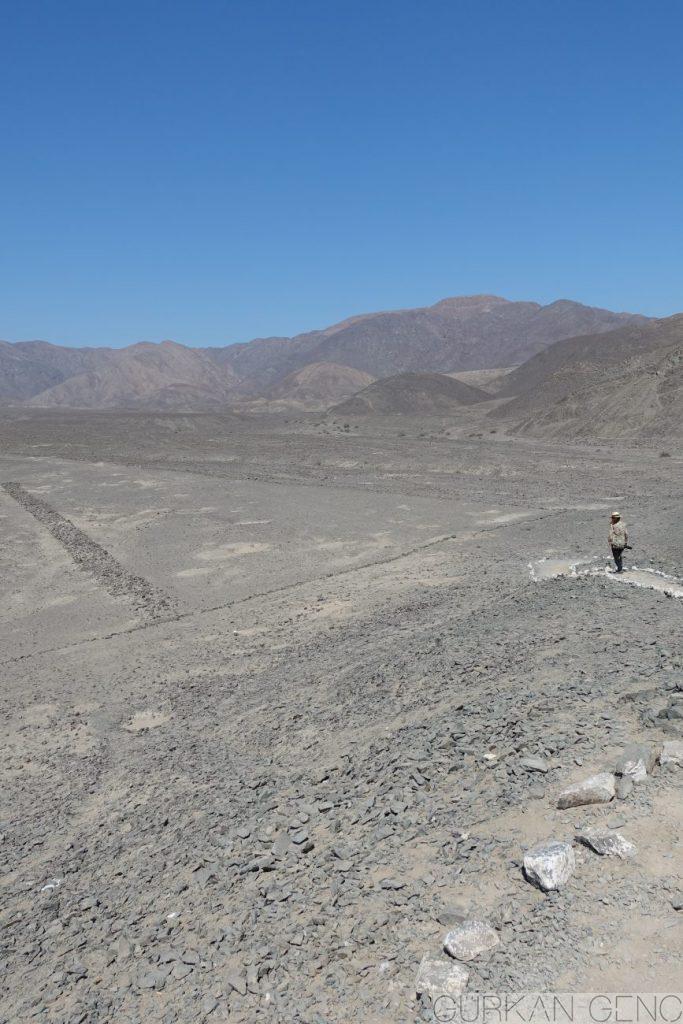
I had never boarded a single engine aircraft before. It is possible to reach only two of the Nasca Lines from the ground, one is located to the north of the city towards Ica, and the other to the east from the city center. Though it is hard to recognize the whole picture, you can go there and see how these lines are drawn. Therefore, I boarded a plane o see those lines better and to photograph them. I was told that there were more than 5000 lines drawn. With the development of aircraft technology, pilots explored and reported these lines.


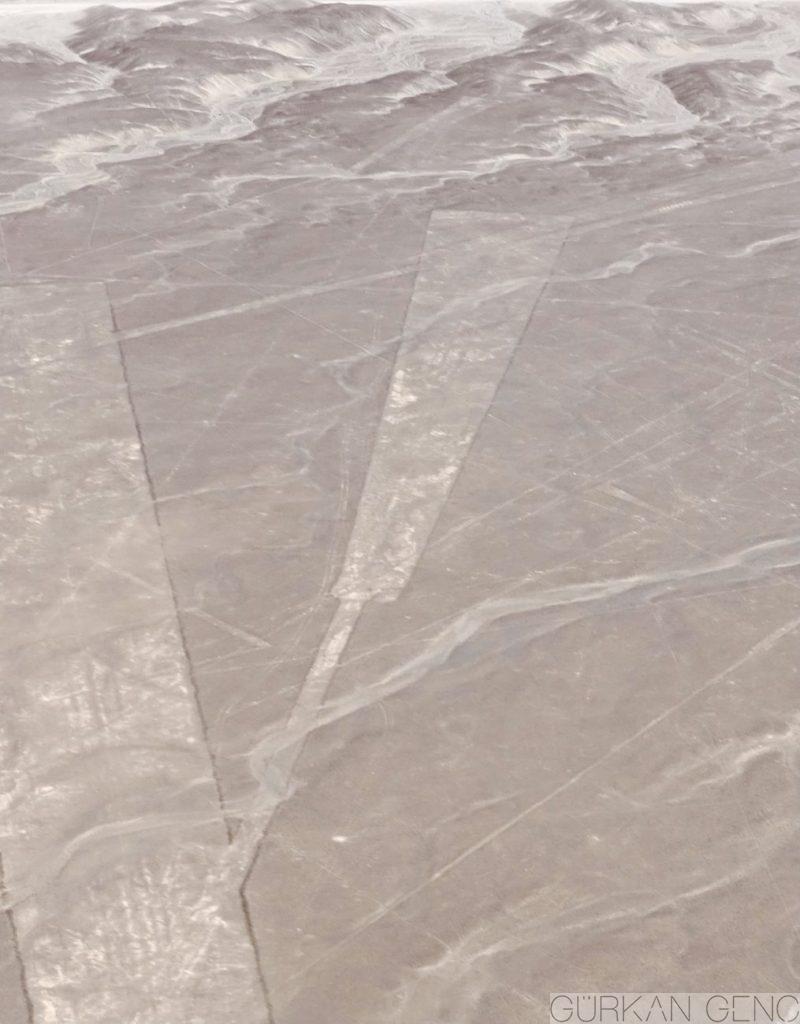
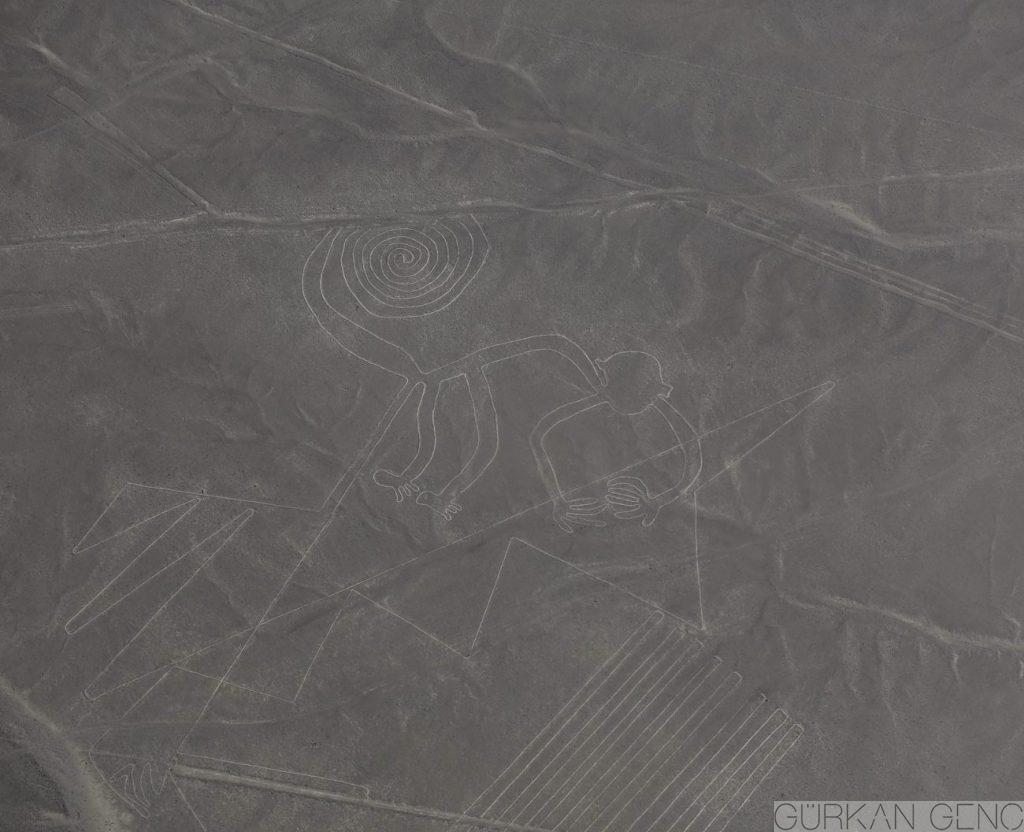
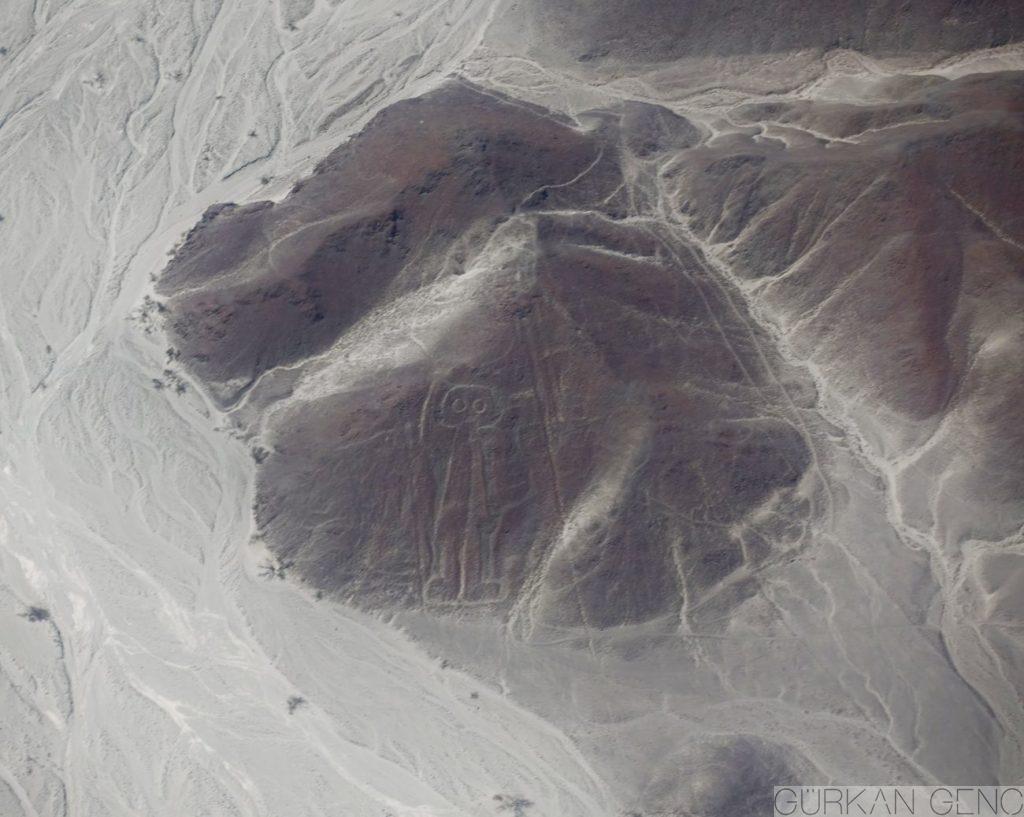
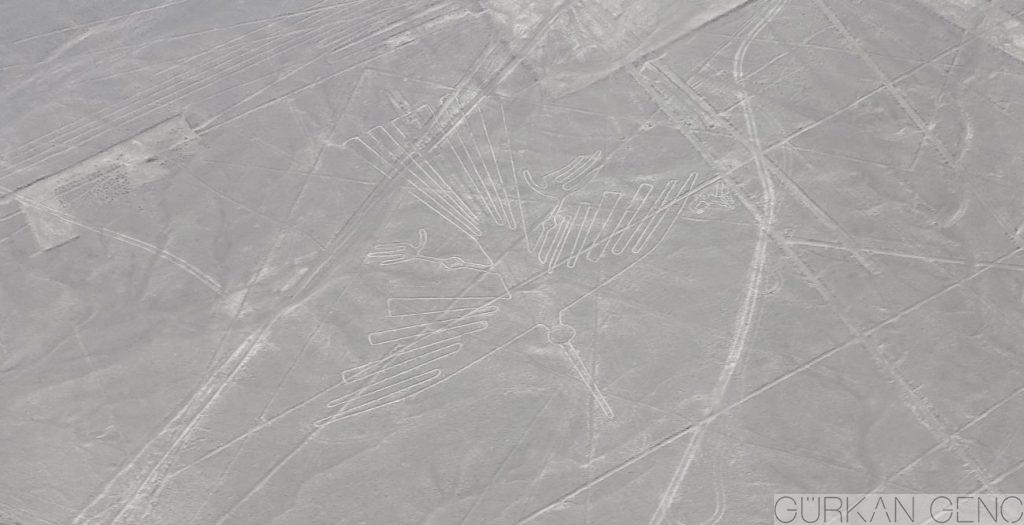
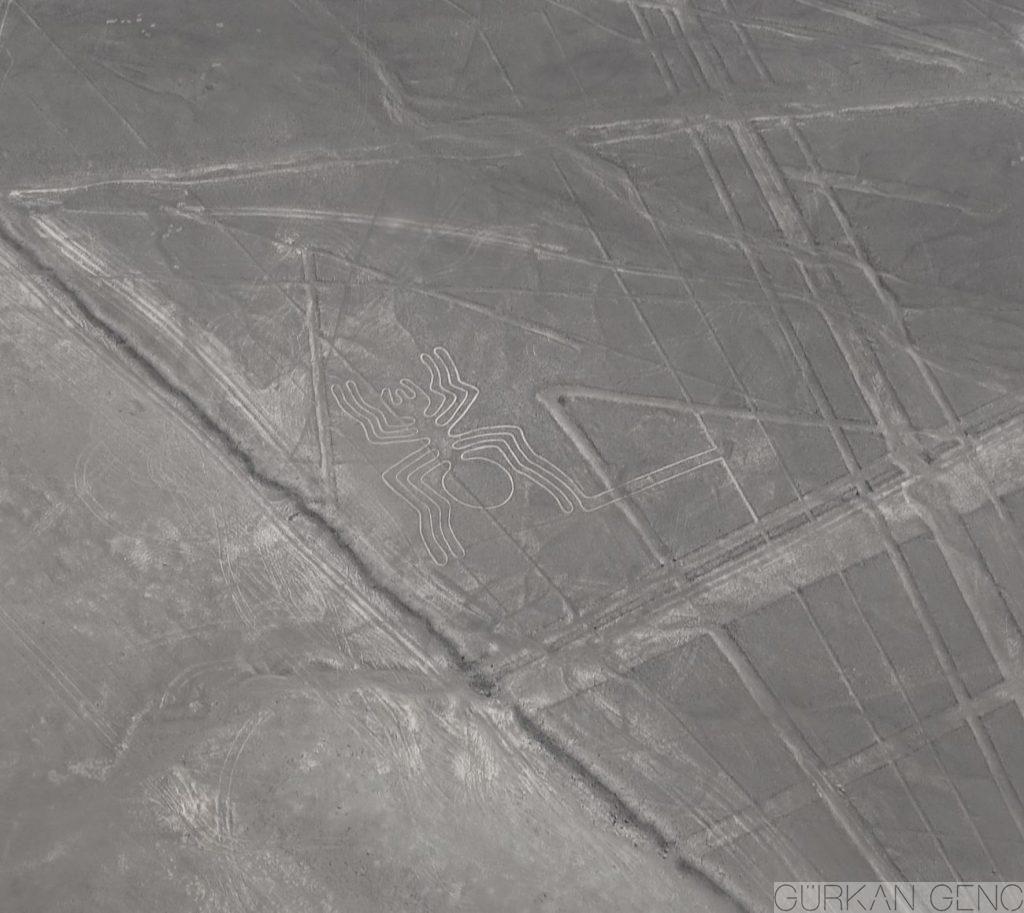
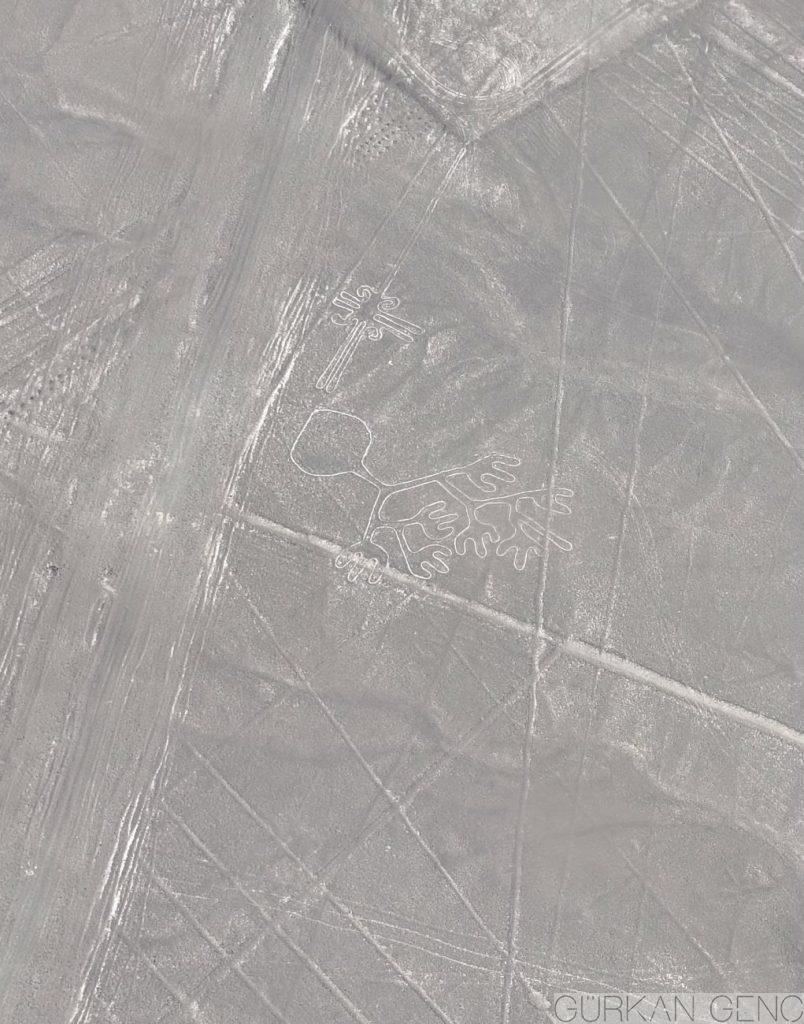
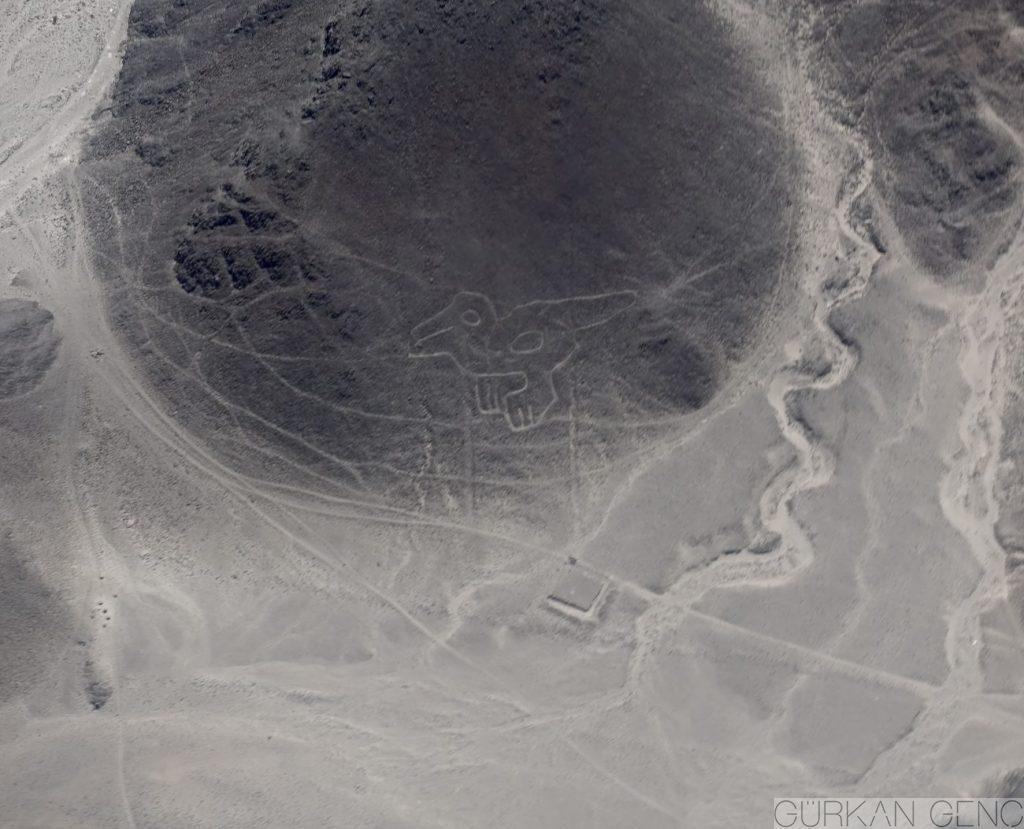

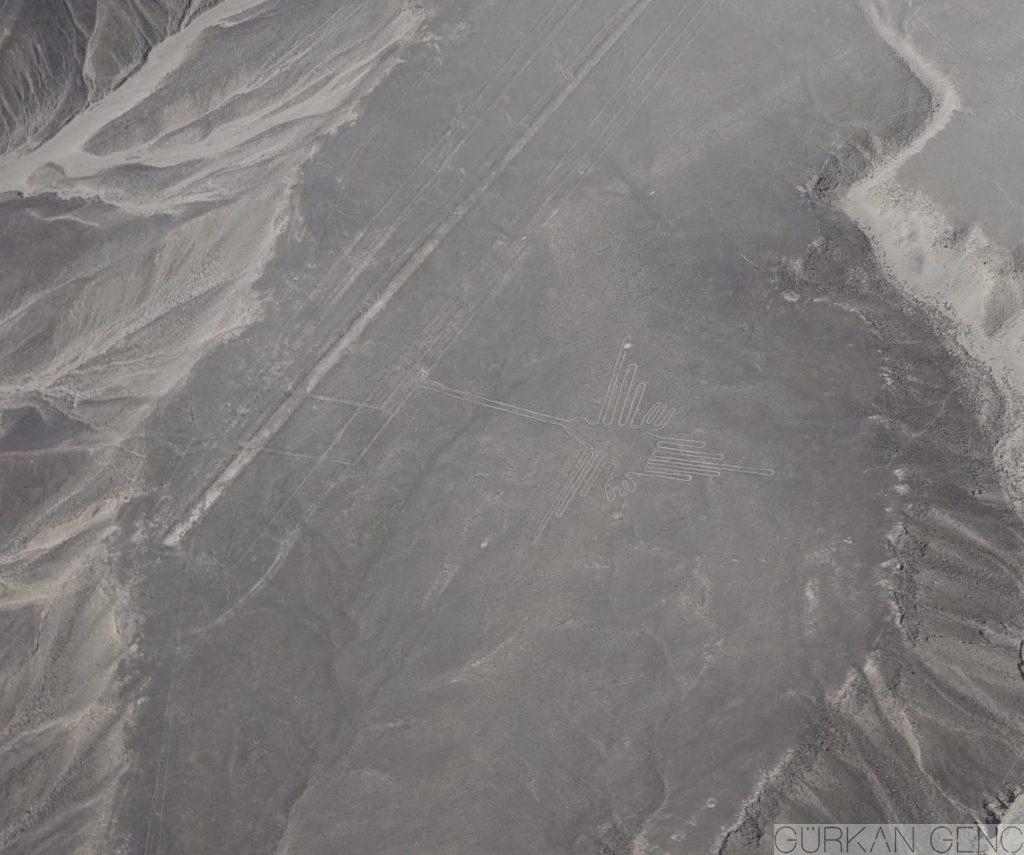
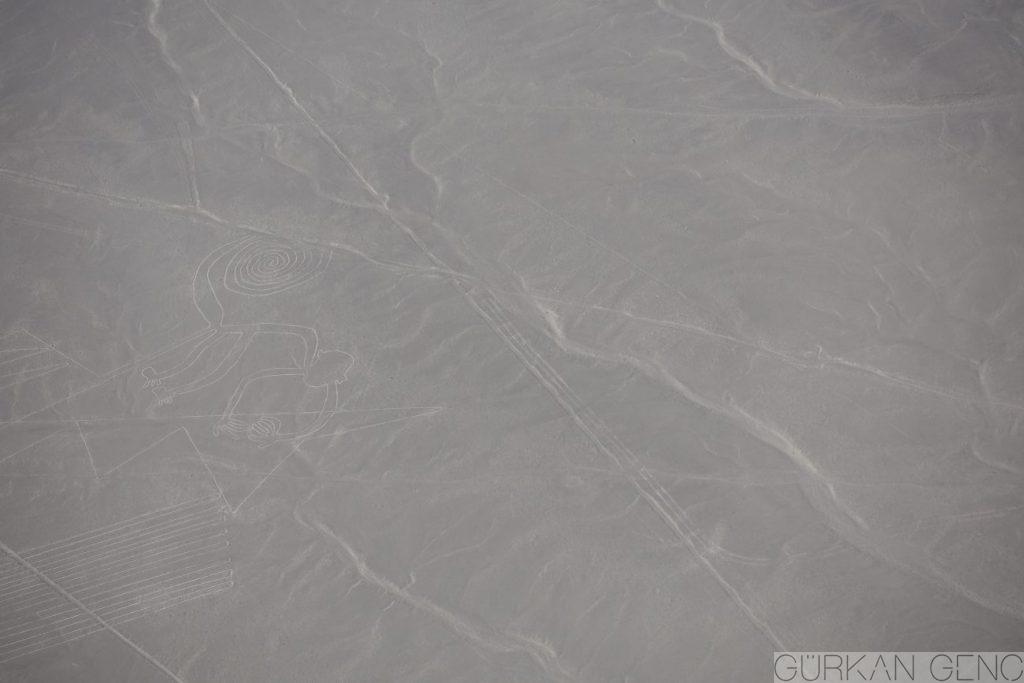
The archeologists explained that those lines were drawn to send messages to the gods. Also, why each line was drawn and what it is representing is explained more or less. According to a research paper published by Japanese archeologist which I have read recently, also the bird figures were identified. That is, to me this does not seem very complicated issue to draw those lines. A society which has drawn symbols of many objects on walls and pillars for centuries would of course be able to draw those lines. But this is a fact: It must have been taken a long time to draw those lines.
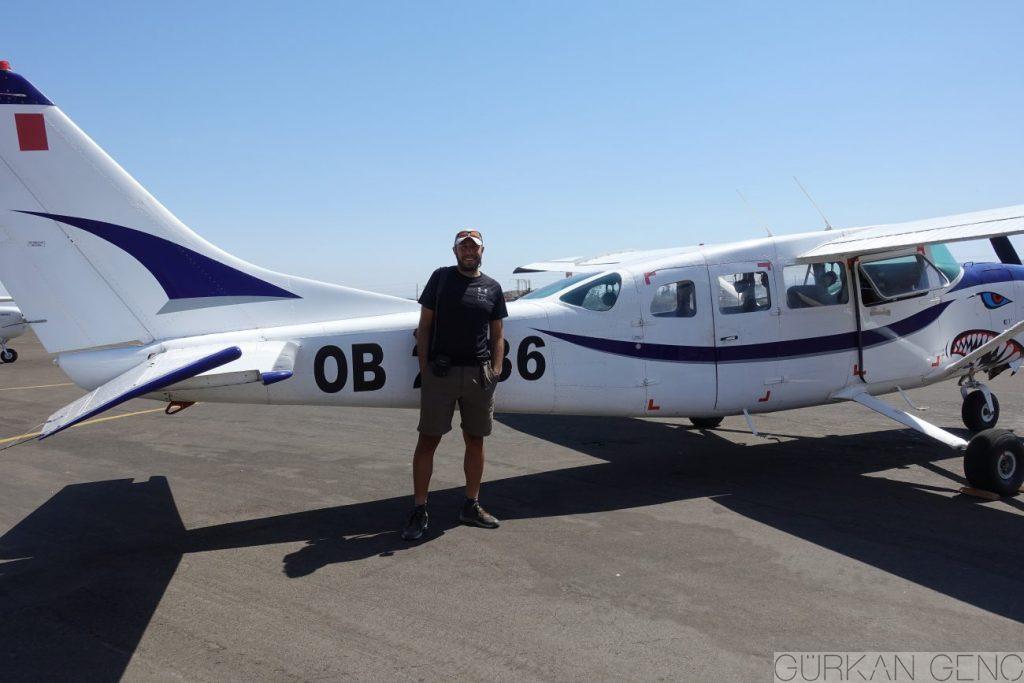

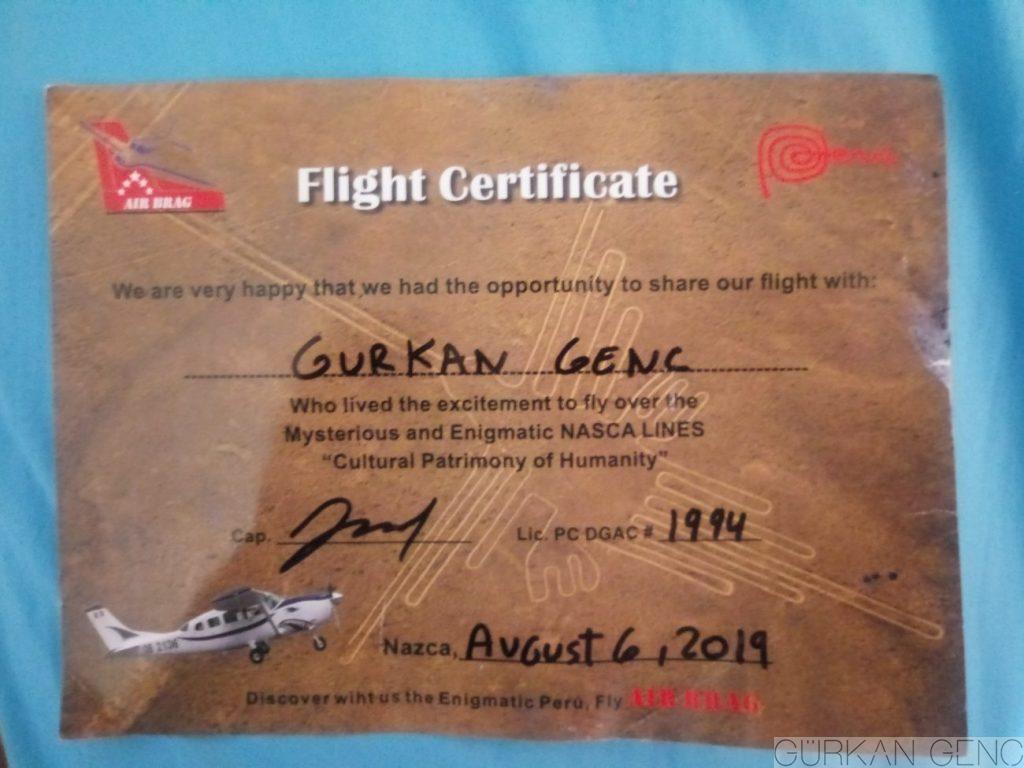
The are two flight options with the single engine aircrafts and four options with the twin engine aircrafts. There are not only the Nasca Lines, but also other lines called after the regions they are explored. Honestly, I’m glad that I have chosen a standard 45 min flight. Longer than that I would throw up (womit) in the plane. I would advise you to have a light breakfast and not ot eat anything before the flight takes place. The pilot zigzags the plane to show the lines below that you see the lines from the side. This could make you uncomfortable as it did me if you are not familiar to such flights.
There is an archeological museum at the Andean side of Nasca. I saw a photograph about the water channels in this region at the museum. These water channels constructed by the Incas still function, later I visited them in situ just out of curiosity. The had built an irrigation system for the agricultural fields. I learned that the piled stones were not placed randomly. How come these channels from Inca period lasted till now? I asked the archeologist accompanying the visit. He replied as: “Every stone placed has the capacity of movement to adjust to earthquakes. In the history of Nasca you see many earthquakes but this area was never affected from them. So, we continue to irrigate our fields as we did before.” As a one who knows the destroyed retaining walls constructed recently, it is worth to see those wall which survived so many earthquakes or other natural disasters. As a one who saw water cisterns still functioning without any restoration requirement, I can say that it is quite acceptable/normal that people with such magnificent stone masonry skills had built such robust constructions. It is worth to see those constructions in Nasca.


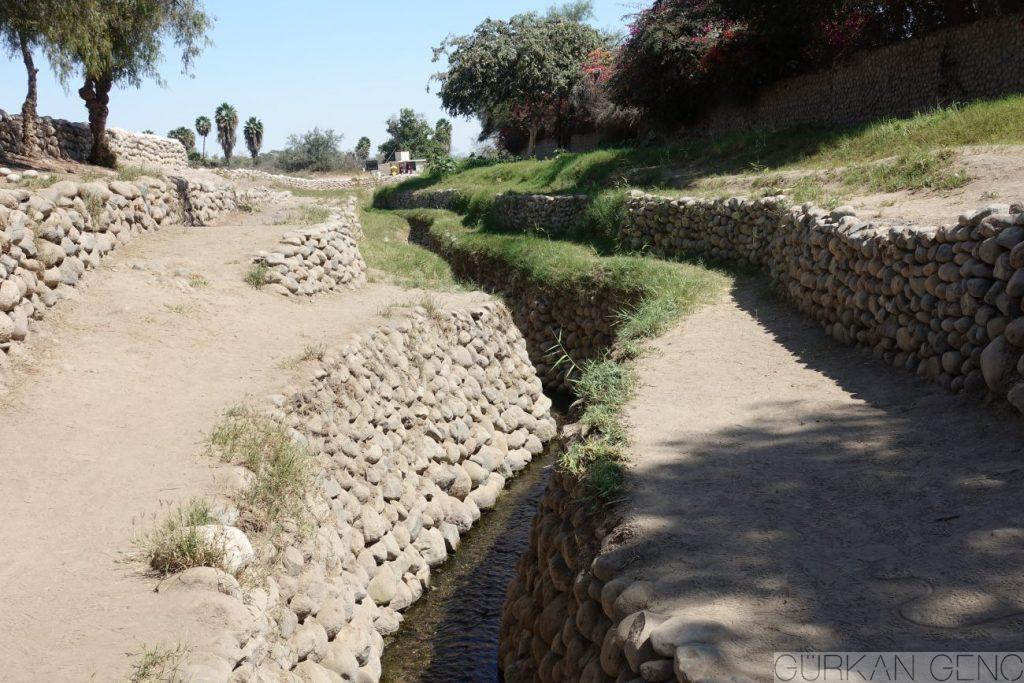
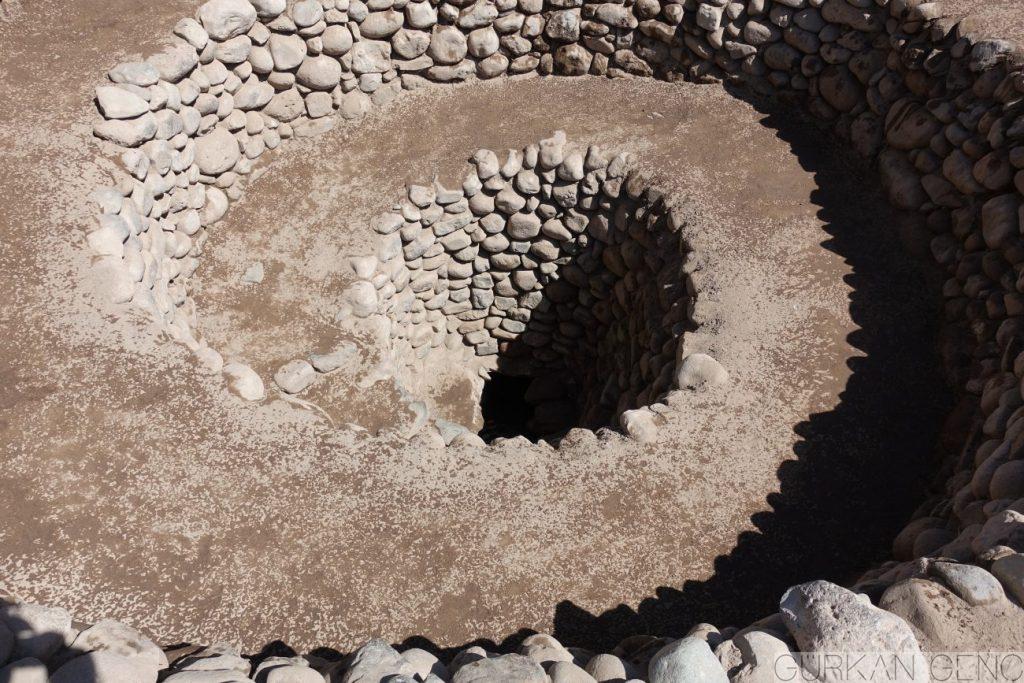

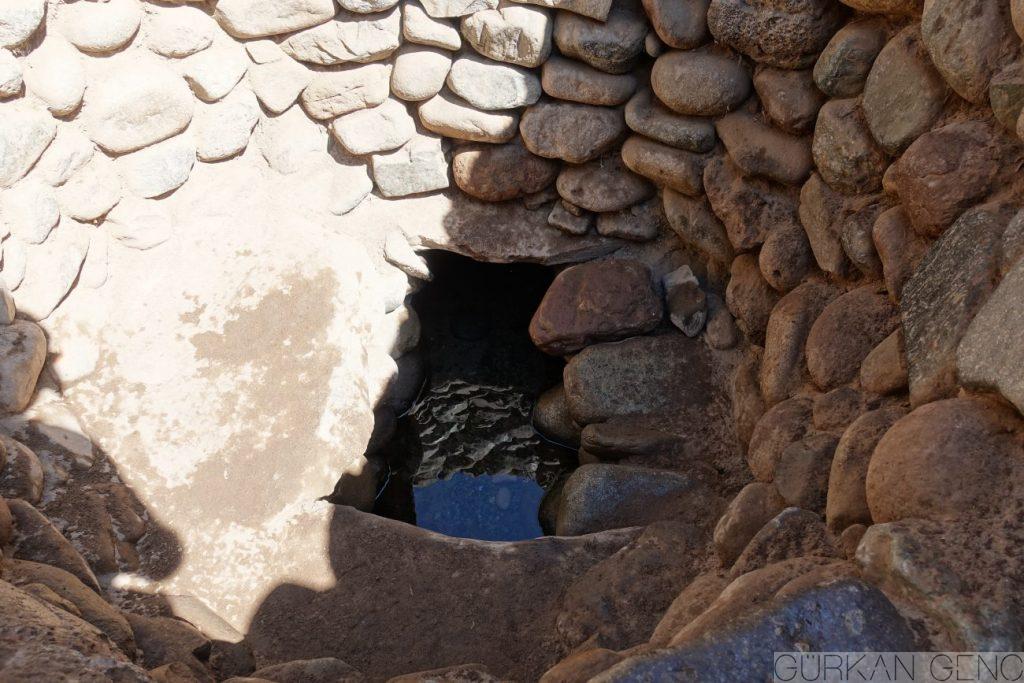

I was feeling sick while riding from Arequipa to Lima. This was not just like having a cold with cough. I was riding above 3000 m altitude for months. Descending to ocean level very fast resulted in change of my blood pressure.

The qualm, headache etc all were the result of high blood pressure I had after Arequipa. There was such a ridiculous situation that my blood pressure dropped during ride and increased as soon as I stopped riding. I was constantly sharing my physical condition with my team mates Mine and Dr. Leman. Though they both wanted me to stop riding right away and take a bus to Lima, I continued to ride at a slow pace since I still felt good enough to ride. Every day, I stopped at villages en route, for 30 minutes and let my blood pressure measured at village clinics. Normally I don’t have high blood pressure. The first thing I’ll do when I arrive in Lima is to have my 80000 km check at a hospital.
I like to listen to travelers or indigenes and learn from their experiences during my journey for the last 10 years and it is impossible to forget all those experiences.
I read the book Art of War written by Sun Tzu every year once more. Also, read Larry King whenever I want to read -How talk to anyone, any time. Experienced people are exactly the same as books. I stopped on the roadside drinking water and looking at the cars passing by. I’m holding a package of biscuits in my hands. I newly left Nasca. I’m talking to myself.
– Dad!! I visited the Nasca lines as I had promised you. Did you see? I must say that I will never fly with a single engineplane, never again. My dear dad, thank you that you inspired and supported me. Thank you. I miss you so much…

While I was lost in thought and talking to myself, a heavily loaded motorcycle parked behind my bike. A man got off the motorcycle and smiled at me. He came next to me and I stood up to welcome him. He is probable a couple of years older than me. Approaching me he keeps smiling and opens his arms to hug me. I start smile and hug him. In seconds my mind takes me back to Uzbekistan 9 years ago. That was such a hug as if you haven’t seen a good friend for years and just saw him again.
-Hi. How is it going? By the way, I’m George.
-Well. How is yours? I’m Gurkan.
-Quite well. Do you have coffee?
– No, but if you have, I can boil water for you.
We are on the roadside on Pan America road somewhere in the desert. I take my stove out and start to boil water. He brings his French press. We seat down on the side of the road and eats snacks and drink coffee. In a silence we look at our iron horses. As usual there are lots of things in my mind. I examine his motorcycle. It is heavily loaded but not due to inexperience. It is obvious, he looks quite experienced. Rather, it seems like he has no time limit or is in no rush. He just takes it easy to start to chat.
- Gurkan, it seems that you are for a long time on the road.
- Do I smell that bad? Hahaha
- Without smelling bad such journeys won’t happen.
Actually, I have to be pretty clean and be good smelling. I just newly had started to ride and had my laundry in Nasca.
- You are Turk and far away from your country. From your look, it is obvious that you are on a long journey.
- I guess, we both are on a similar journey. Maybe, our starting points are different. I travel because I’m curious. I have time and are not on rush. I don’t need to proof anything to anybody. I’m both working and traveling to my own taste at the same time for years. This is my story.
- Before, I also wanted to travel the world because of curiosity but couldn’t do. I ended my conversations, saying that I wanted to travel but why I could not. How nice, you started your journey deciding why and how you want to travel from the beginning on.
George started to travel from USA. He rode from east to southwest first and arriving in the south started to follow west side till Alaska. From Alaska he rode to the capital of Canada and then from west side again to the south through middle states of USA. Then, he traveled through all the countries in Central and South America on his motorbike. He zigzagged and drew circles in both continents and not at different time periods. He started in 2016 and is still continuing his journey. It seems that he visited every state and town on his route. I always say that if I were travelling on motorbike, I would not follow a straight line, would zigzag towards every direction possible. I would do it exactly the same way as George was doing. For sure! He was on a world tour and share his remaining route with me: Visit every country in Africa, Australia, Europe, Asia drawing circles, zigzagging. A wonderful journey.. He took sip from his coffee!
– Life gives you everything what you want or what you deserve in a way. That is what I better understood in this journey, Gurkan
[P.S.: People reading my road memories and also the 56th question in frequently questions asked section and its answer witness for years this sentence of George].
George always wanted to travel and see the world. He used to say: “I’m married and father of 3 children. How can I leave them behind and travel around the world? But if I would have a family, I would definitely realize this dream.”. One day, all his family members die in a car accident. He also had to fight for his life for a long time after this accident. When he won his battle against death, he regrated his words and got depressed. “How come could I say this? I would give my life for their lives. If only I had let them share my dream, we would be traveling together. Now, I’m traveling the world without them but with their souls, Gurkan”…
I chatted with George for about one hour at the roadside in the middle of the desert. We hugged each other for a long time while saying good-bye to each other. Then after, we each continued on our own road.